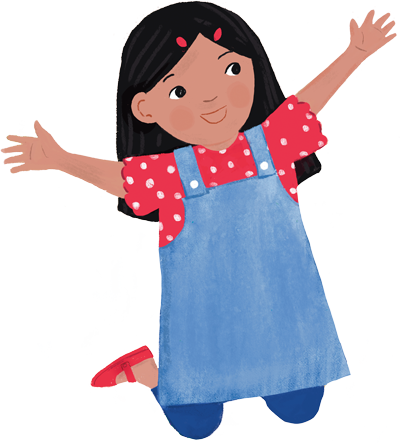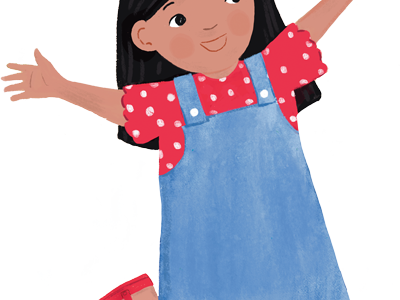
“This vibrantly illustrated book is a quiet tribute to intergenerational relationships and family traditions. A tender, gentle tale that will help children live in the moment.”
–Kirkus Reviews
In Farida Zaman’s new picture book, Meena Can’t Wait, a young girl goes to her grandmother’s house for a tea party and helps her make a special Bengali tea called doodh cha. Hear from Farida about what inspired her to write this story and what she hopes young readers will take away from it.
What inspired you to write Meena Can’t Wait?
The idea for Meena Can’t Wait was borne out of the deep bond I shared with my grandmother. My childhood memories are filled with her warm, comforting presence and her amazing gift of storytelling.
The story of Meena’s excitement and impatience reflects those childhood moments in which my nani—my grandmother—would sit with me, helping me navigate my excitement and curiosity about the world. In many ways, Meena’s relationship with her nani, who she calls Nanu, mirrors my own journey of learning from my grandmother’s quiet strength and deep well of patience. In writing Meena Can’t Wait, I wanted to honor that relationship.
What was your process like when creating the book? Did you write and illustrate at the same time, or did one step come before the other?
When it came to creating Meena Can’t Wait, my process started with the story itself. Writing came first as I wanted to lay down a solid foundation for the narrative before diving into the illustrations. I knew that in order to bring Meena’s character to life and communicate the central themes of excitement and anticipation, the story had to be clear, engaging and emotionally resonant. After the writing was complete, I transitioned to the illustration phase. At this point I already had a clear picture in my mind of how Meena and the other characters would look and move through the story. I began sketching out rough drafts of each scene, focusing on how the illustrations would interact with the text. I wanted the images to not only complement the story but also bring out the emotions that words alone couldn’t capture.
The relationship between Meena and Nanu is a central focus of the book. Can you discuss the importance of portraying strong intergenerational relationships for young readers?
In Meena Can’t Wait, the relationship between Meena and Nanu is central to the story, and I felt it was crucial to highlight this bond for a number of reasons. Intergenerational relationships, especially between grandparents and grandchildren, carry a unique richness and depth. For young readers, these relationships can offer a sense of connection, continuity and wisdom that complements the more immediate influences of parents and peers.
Grandparents often hold a lifetime of experience and knowledge, and they pass down values, traditions and life lessons that might not be immediately apparent to younger generations. In Meena Can’t Wait, Nanu is not just a passive observer of Meena’s excitement—she is a guiding figure who teaches Meena the significance of patience and the joy that comes with waiting for something special.
A colorful parrot appears on multiple pages. Does this parrot have any symbolic meaning?
One of the most important roles the parrot plays in the story is to represent curiosity and playfulness. Much like Meena, who is eager and full of energy, the parrot is lively and inquisitive, reflecting the mood of the protagonist. Its bright colors and playful demeanor mirror Meena’s excitement as she eagerly awaits the surprise that Nanu has in store for her. The parrot, in this sense, serves as a visual extension of Meena’s emotions—its flitting around from page to page symbolizes her restless anticipation.
The book includes your family recipe for doodh cha, the same tea that Meena and her nani make. What inspired you to include the recipe in the book?
I wanted to include my family’s doodh cha recipe in Meena Can’t Wait because the recipe is a significant part of the story, as it’s the same tea that Meena and Nanu make together; it symbolizes the warmth, love and shared moments that define their relationship. In the end, including the recipe was about more than offering a fun activity for readers—it was a way to connect the story to my own heritage and invite families into the experience.
For children, the act of making tea with a parent or grandparent can become a special ritual—an opportunity to create memories, just as Meena does. By giving readers a tangible way to participate in the story, the recipe helps extend the experience beyond the pages of the book.
We can all relate to waiting impatiently for a tasty treat. Are there any other favorite treats your family made while you were growing up?
In my family there were quite a few special foods that made the waiting worthwhile. While I was growing up, food wasn’t just about sustenance—it was an integral part of family gatherings, celebrations and even quiet, everyday moments. Some of my favorite treats, like the doodh cha in Meena Can’t Wait, carry strong memories of love, warmth and togetherness. These treats didn’t just satisfy my taste buds; they became symbolic of the care and effort my family put into creating moments of joy.
One of the most cherished treats in my family was gajar ka halwa, a slow-cooked carrot pudding that takes time, patience and plenty of stirring to prepare. I remember the smell of carrots simmering in milk and sugar, spiced with cardamom, filling the house as the halwa slowly thickened on the stove. Like doodh cha, there were no shortcuts when making it, and the anticipation only made it more special.
Another treat that holds a special place in my heart is samosas. These crispy, savory pastries filled with spiced potatoes and peas were often made in batches during family get-togethers. Making samosas was a communal activity in our household, with everyone taking on different roles—kneading the dough, preparing the filling and folding the samosas into their characteristic triangular shapes. The best part about samosas was enjoying them with a good cup of doodh cha!
Lastly, I can’t talk about favorite family treats without mentioning parathas, a type of stuffed flatbread. While they might not be a dessert, they were definitely something I eagerly waited for during family breakfasts. My favorite was aloo paratha, filled with spiced mashed potatoes. My grandmother would roll out the dough, stuff it with the filling and cook the parathas on a hot griddle until they were perfectly golden and crispy on the outside, yet soft and tender on the inside.
What do you hope young readers will take away from this story?
At its core, Meena Can’t Wait is a story about patience, anticipation and the valuable lessons that can come from waiting for something special. Through Meena’s journey, I hope young readers come away with several important takeaways that resonate with them, not only in the context of the story, but also in their own lives.
In today’s fast-paced world, where instant gratification is often the norm, children can find it especially difficult to wait for things. Meena’s impatience and excitement are emotions that every child can relate to, whether they’re eagerly anticipating a birthday party, a new toy, or a fun surprise. However, through her journey, Meena learns that good things often take time and that the experience of waiting can be rewarding in its own right. I hope young readers will see that sometimes anticipation can enhance the joy of the moment when it finally arrives. The story is a reminder that not everything happens instantly, and that’s okay—some of the best things in life are worth the wait.
I also want children to understand that the connections they have with their grandparents, parents or other family members are incredibly special. These relationships are often filled with stories, traditions and valuable life lessons that can shape who they are.
Finally, I hope young readers will see that grandparents (and older family members) can offer so much wisdom, comfort and companionship. A key aspect of the story is the strong bond between Meena and Nanu. Their relationship is warm, nurturing and full of love. Through Nanu’s patient guidance, Meena not only learns the value of waiting, but also feels supported and loved.
What’s next for you? Do you have other books in the works?
I’m currently working on two exciting new books—one that will be published by Owl Kids in spring 2026 and another that will follow shortly after in fall 2026. I can’t wait to share these stories with the readers soon!

Farida Zaman is a multi-disciplinary artist and writer who is well known for her whimsical, uplifting designs. She has illustrated fourteen picture books, including When Mom’s Away, Ta-Da! and The Yoga Game, and is the author/illustrator of I Want To Be… A Gutsy Girls’ ABC. Born in Bangladesh, and having called many different countries home, Farida describes herself as a global citizen with a flair for illustrating stories related to different cultures. She trained in fine art and illustration at the Chelsea School of Art and the Wimbledon School of Art in London, England, where she graduated top of her class with honors. Farida lives in Toronto.
Photo by Aidan Samuel.


